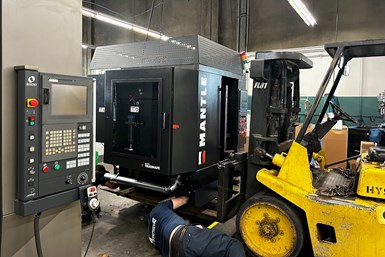Westec Plastics Partners With Mantle to Speed Tooling Production
Using Mantle's technology, Westec says it can complete up to 70% of the job and have its toolmakers handle the specialized steps only humans can do.
Westec Plastics, an ISO-certified plastic injection molder serving medical, consumer and industrial customers, installed a Mantle P-200 production system which resulted in reduced active operations from 40 hours to 10 hours.
The P-200 metal 3D printer is specifically designed to create injection mold tooling, bringing a new level of speed and flexibility to Westec’s existing tooling capabilities. Westec's Livermore, California, headquarters features 23 injection molding presses and an extensive range of equipment for secondary operations. Its headquarters also features a full in-house tool room.
“Using Mantle's technology, we can complete up to 70% of the job and have our toolmakers handle the specialized steps only humans can do,” says Tammy Barras, president at Westec Plastics. “With Mantle, we can provide our customers a service they can't get anywhere else.”
Westec is using the Mantle metal 3D printer to rapidly produce prototype and production mold inserts, and increase its total toolmaking capacity. This also helps address labor challenges. The company says it can also engage with its customers earlier in the design process by printing prototype inserts in H13 .
“We couldn't be happier about our partnership with Westec as we continue to ship systems that revolutionize the tooling industry,” says Ted Sorom, Mantle CEO and co-founder.
The metal 3D printing technology enables Westec to respond more quickly to evolving customer requirements and get injection molded parts into customers’ hands more quickly. Also, the ability to print production-ready mold inserts using industry-standard materials such as H13 tool steel enables Westec to free up experienced toolmakers’ time to focus on specialized steps like tool repair and maintenance.
Using the Mantle technology, Westec says it has been able to cut lead times in half to produce a mold for a medical diagnostic part, helping to keep the design and development process on track.
- Read about the benefits of 3D printing molds with metal paste and watch this video of the Mantle process explained. Metal paste is the starting point for a process using 3D printing, CNC shaping and sintering to deliver precise H13 or P20 steel tooling for plastics injection molding. Peter Zelinski talks through the steps of the process in this video filmed with Mantle equipment.
- Read more about how Mantle’s 3D printed molds address plastics industry lead time and skills shortage. Steel mold tooling from its TrueShape process can be printed, shaped and sintered in days, and with fewer steps, compared to weeks of lead time for molds made conventionally.
Related Content
-
Foundry Lab: How Casting in a Day Will Improve the Design of Metal Parts (Includes Video)
The company’s digital casting process uses 3D printing, but the result is a cast part. By providing a casting faster than a foundry, the company says effective prototyping is now possible for cast parts, as well as bridge production.
-
The Connector Conundrum: 3D Printed Mold Tooling’s Role in Innovation
ReelView Fishing faced an electronics obstacle in the development of its new technology for underwater video. Additive manufacturing for moldmaking allowed for the speed necessary to iterate to a solution. How inventors and invention will benefit from new ways of obtaining production-ready tooling.
-
Q&A With Align EVP: Why the Invisalign Manufacturer Acquired Cubicure, and the Future of Personalized Orthodontics
Align Technology produces nearly 1 million unique aligner parts per day. Its acquisition of technology supplier Cubicure in January supports demand for 3D printed tooling and direct printed orthodontic devices at mass scale.















